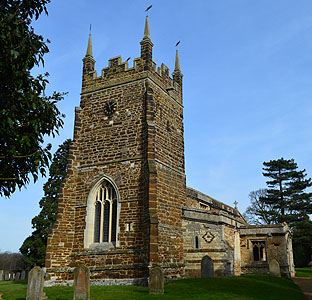Early Education in Everton

The church from the south-west February 2013
Volume 81 published by Bedfordshire Historical Records Society (2002) is a series of episcopal visitations undertaken in the first twenty years of the 18th century, edited by former County Archivist Patricia Bell. At each visitation a list of questions was sent out in advance, one of which enquired about the provision of schools in each parish. Everton was unlike the rest of the county in being in the Archdeaconry of Huntingdon rather than the Archdeaconry of Bedford. In 1706 the vicar reported: “There is no lecture, School, Almes-house, or Hospitall endowed in this parish. No Charity Schole”.
In 1818 a Select Committee was established to enquire into educational provision for the poor. This was no doubt prompted, in part, by the recent foundation of two societies promoting education and specifically the building of schools. The Society for Promoting the Lancasterian System for the Education of the Poor was established in 1808 promoting schools run along the lines pioneered by Joseph Lancaster, who had himself copied those of Dr. Andrew Bell, in which older children taught their younger fellows. The Society was renamed the British and Foreign School Society in 1814,. It was supported by a number of prominent nonconformists, Lancaster himself was a Quaker, and sought to teach a non-sectarian curriculum. In answer to this perceived nonconformist takeover of local education the National Society was formed in 1811 to encourage the teaching of poor children along Anglican lines, including the catechism. The Select Committee sent a questionnaire to all parishes in the country asking for: particulars relating to endowments for the education of children; other educational institutions; observations of parish needs etc. The curate reported that there was no daily school, though there was a Sunday school, “open to all the children gratis, in which about 46 are instructed; and 14 children are educated at the expense of Stephen Thornton, esquire, of Moggerhanger, and 3 by William Astell, esquire at a dame’s school”. In those days a Sunday school was just that, a school which met on a Sunday, usually in the church or nonconformist chapel or other similar building, teaching more than the religious topics with which they are associated today. The vicar concluded: “The poor possess sufficient means of education”.
In the country generally the number of schools built continued to grow over the next fifteen years so that by 1833 the government agreed to supplement the work of the two societies, and local benefactors, by making £20,000 per annum available in grants to help build schools. It also prompted another questionnaire to be sent to each parish in England asking for details of local educational provision. The correspondent for Everton replied: “One Sunday school at Tetworth [Huntingdonshire], with which this parish is united”.